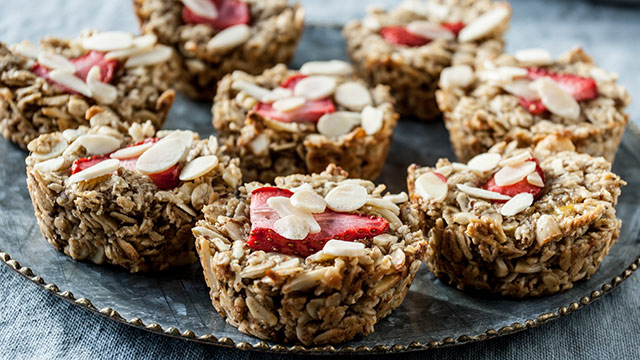Nourish
THE LATEST SCIENCE ON HOW TO HYDRATE
Fatigue, dizziness, confusion—dehydration has a serious impact on our bodies and minds. But how much water do we really need to hydrate? And how can we gauge our hydration levels to make sure we don’t get to the point where we’re feeling the symptoms above?
We asked Dr. Louise Maharam, sports-medicine and running-health expert, to walk us through the latest in hydration research. To perform at your peak before, during, and after your next workout, here’s what you need to know.
8 CUPS A DAY IS OLD NEWS
Dr. Maharam says that this bit of advice is old news because each of our bodies is unique. “There’s no one size fits all,” he says. You have to assess your own situation based on factors including the surface area of your body, your activity level, and how much you sweat. Other variables including sleep, temperature, and humidity, can play a role, too. And remember: If you’re pregnant or nursing, your need for water dramatically increases.
YOU MIGHT NEED MORE THAN WATER
When exercising vigorously for more than an hour, you might need a little something extra to rehydrate. A recent study published in the Journal of American Clinical Nutrition showed that orange juice and milk had higher hydration rates than water—which means that your body holds onto the liquid in those drinks longer than it does with straight water. This isn’t to say that you should gulp these liquids right after a workout, especially given the sugar and lack of stabilizing fiber in juice and how well your body digests dairy, but it’s good to keep in mind for those extra sweaty workouts. You can try a natural version of a sports drink or reach for a glass of coconut water, which usually has natural sodium and sugars that can help rehydrate.
YOUR PEE HOLDS THE KEY
The only way to really tell if you’re drinking the right amount of water is to look at your urine. If you’re perfectly hydrated, it will be the color of diluted lemonade. If you’re not drinking enough, it will look like iced tea. And if it’s clear? You might be drinking too much, which can be counterproductive to your wellness goals. (In the extreme, overhydration can actually be dangerous to your health, too.) Here’s a handy reference chart.
FOOD CAN HYDRATE, TOO
We tend to think liquids when we think hydration, but many foods contain high water content, too. For example, citrus, melon, tomatoes, cucumbers, zucchini, greens, and other fruit are full of water. You can also try starting the day with a smoothie, and consider soup for dinner.
WAKE UP YOUR WATER
If you get bored with plain old water, liven it up by infusing it with fruits and herbs. Need inspo? Check out our piece on spa water.
Fatigue, dizziness, confusion—dehydration has a serious impact on our bodies and minds. But how much water do we really need to hydrate? And how can we gauge our hydration levels to make sure we don’t get to the point where we’re feeling the symptoms above?
We asked Dr. Louise Maharam, sports-medicine and running-health expert, to walk us through the latest in hydration research. To perform at your peak before, during, and after your next workout, here’s what you need to know.
8 CUPS A DAY IS OLD NEWS
Dr. Maharam says that this bit of advice is old news because each of our bodies is unique. “There’s no one size fits all,” he says. You have to assess your own situation based on factors including the surface area of your body, your activity level, and how much you sweat. Other variables including sleep, temperature, and humidity, can play a role, too. And remember: If you’re pregnant or nursing, your need for water dramatically increases.
YOU MIGHT NEED MORE THAN WATER
When exercising vigorously for more than an hour, you might need a little something extra to rehydrate. A recent study published in the Journal of American Clinical Nutrition showed that orange juice and milk had higher hydration rates than water—which means that your body holds onto the liquid in those drinks longer than it does with straight water. This isn’t to say that you should gulp these liquids right after a workout, especially given the sugar and lack of stabilizing fiber in juice and how well your body digests dairy, but it’s good to keep in mind for those extra sweaty workouts. You can try a natural version of a sports drink or reach for a glass of coconut water, which usually has natural sodium and sugars that can help rehydrate.
YOUR PEE HOLDS THE KEY
The only way to really tell if you’re drinking the right amount of water is to look at your urine. If you’re perfectly hydrated, it will be the color of diluted lemonade. If you’re not drinking enough, it will look like iced tea. And if it’s clear? You might be drinking too much, which can be counterproductive to your wellness goals. (In the extreme, overhydration can actually be dangerous to your health, too.) Here’s a handy reference chart.
FOOD CAN HYDRATE, TOO
We tend to think liquids when we think hydration, but many foods contain high water content, too. For example, citrus, melon, tomatoes, cucumbers, zucchini, greens, and other fruit are full of water. You can also try starting the day with a smoothie, and consider soup for dinner.
WAKE UP YOUR WATER
If you get bored with plain old water, liven it up by infusing it with fruits and herbs. Need inspo? Check out our piece on spa water.










One person has left a comment. Join the conversation!
View Comments